二语习得中介语
浅析中介语在二语习得中的正迁移现象[合集五篇]
![浅析中介语在二语习得中的正迁移现象[合集五篇]](https://img.taocdn.com/s3/m/391a2e47dcccda38376baf1ffc4ffe473368fd31.png)
浅析中介语在二语习得中的正迁移现象[合集五篇]第一篇:浅析中介语在二语习得中的正迁移现象浅析中介语在二语习得中的正迁移现象一、中介语的定义中介语(interlanguage)是指外语学习过程中学习者使用的介于母语(native language)与目标语(target language)之间的一种语言体系。
这种语言系统在语音、词汇、语法、语用等方面,既不同于我们的第一语言,也不同于所学习的目的语,而是一种随着学习的发展向目的语的正确形式逐渐靠拢的一种动态的语言系统。
二语习得者都是从母语出发,经过中介语,达到目标语。
中介语是母语和目标语之间的一座桥梁,是二语习得中认知过程的必经之路。
中介语是一种既独立于母语和目标语之外,同时与两者有着密切相关性的语言体系。
二、中介语在第二语言学习中正迁移现象的分析(一)语音迁移汉语和英语的语音体系有着明显的区别:两种语言对语音的音高、音强和音长的敏感程度各不相同。
英语对音强变化非常敏感,因此被列为重音语言。
汉语则对音高变化比较敏感,是典型的声调语言。
在英语中元音的长短、松紧可以区别词汇意义,例如: beat [ bi: t ]和bit[ bit ] , fool[ fu: l ]和full[ ful ]。
然而在汉语普通话里却没有这种元音的松紧、长短的对立。
这些不同点构成了学英语的中国学生发音上的障碍。
但是,英语和汉语中的许多拟声词在发音上有相似之处,如clatter与“咔哒”,mamma与“妈妈”等。
一些外来词大都发音近似。
例如: guitar—吉他, sofa—沙发。
一些地名、人名、货币名称等也属于这种情况。
这些都说明在语音领域汉语和英语可发生正迁移。
我是烟台人,我的方言中“儿化音”(例如:这件事儿。
你去哪儿?我要去方特儿玩儿。
)特别多,同时英语美音中有很多“卷舌音”,这对我练习英语的美式发音带来了很大的帮助,但是学习英式发音就比较困难了。
在来大学前,我就知道法语中的“Bonjour,Salut”词汇与汉语中的“笨猪,儍驴”发音很相近,这使我对法语产生了很大的兴趣,于是二外毫不犹豫的选择了法语。
二语习得中的中介语僵化现象及应对策略
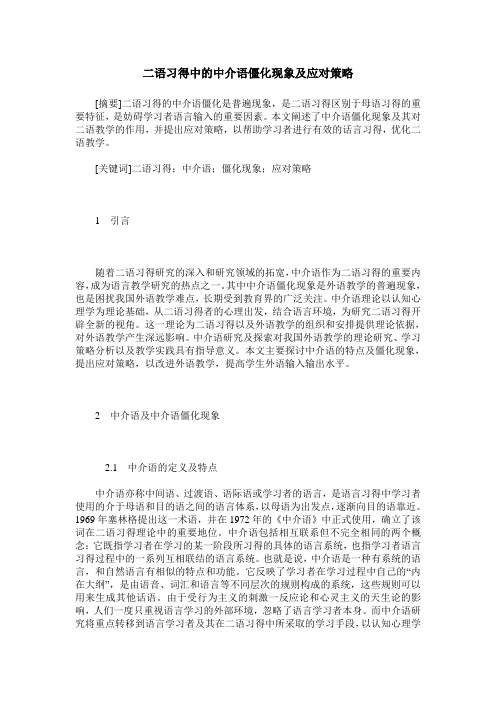
二语习得中的中介语僵化现象及应对策略[摘要]二语习得的中介语僵化是普遍现象,是二语习得区别于母语习得的重要特征,是妨碍学习者语言输入的重要因素。
本文阐述了中介语僵化现象及其对二语教学的作用,并提出应对策略,以帮助学习者进行有效的话言习得,优化二语教学。
[关键词]二语习得;中介语;僵化现象;应对策略1引言随着二语习得研究的深入和研究领域的拓宽,中介语作为二语习得的重要内容,成为语言教学研究的热点之一。
其中中介语僵化现象是外语教学的普遍现象,也是困扰我国外语教学难点,长期受到教育界的广泛关注。
中介语理论以认知心理学为理论基础,从二语习得者的心理出发,结合语言环境,为研究二语习得开辟全新的视角。
这一理论为二语习得以及外语教学的组织和安排提供理论依据,对外语教学产生深远影响。
中介语研究及探索对我国外语教学的理论研究、学习策略分析以及教学实践具有指导意义。
本文主要探讨中介语的特点及僵化现象,提出应对策略,以改进外语教学,提高学生外语输入输出水平。
2 中介语及中介语僵化现象2.1中介语的定义及特点中介语亦称中间语、过渡语、语际语或学习者的语言,是语言习得中学习者使用的介于母语和目的语之间的语言体系,以母语为出发点,逐渐向目的语靠近。
1969年塞林格提出这一术语,并在1972年的《中介语》中正式使用,确立了该词在二语习得理论中的重要地位。
中介语包括相互联系但不完全相同的两个概念:它既指学习者在学习的某一阶段所习得的具体的语言系统,也指学习者语言习得过程中的一系列互相联结的语言系统。
也就是说,中介语是一种有系统的语言,和自然语言有相似的特点和功能。
它反映了学习者在学习过程中自己的“内在大纲”,是由语音、词汇和语言等不同层次的规则构成的系统,这些规则可以用来生成其他话语。
由于受行为主义的刺激一反应论和心灵主义的天生论的影响,人们一度只重视语言学习的外部环境,忽略了语言学习者本身。
而中介语研究将重点转移到语言学习者及其在二语习得中所采取的学习手段,以认知心理学为理论基础,其核心问题是学习者的语言。
二语习得中介语以及对外语教学的启示文献综述
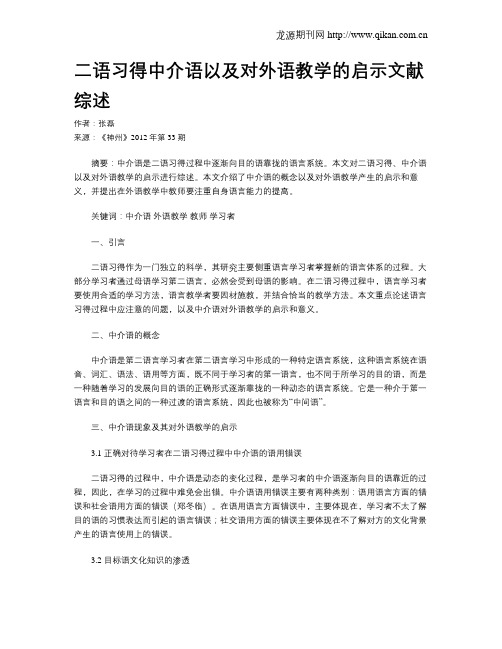
二语习得中介语以及对外语教学的启示文献综述作者:张磊来源:《神州》2012年第33期摘要:中介语是二语习得过程中逐渐向目的语靠拢的语言系统。
本文对二语习得、中介语以及对外语教学的启示进行综述。
本文介绍了中介语的概念以及对外语教学产生的启示和意义,并提出在外语教学中教师要注重自身语言能力的提高。
关键词:中介语外语教学教师学习者一、引言二语习得作为一门独立的科学,其研究主要侧重语言学习者掌握新的语言体系的过程。
大部分学习者通过母语学习第二语言,必然会受到母语的影响。
在二语习得过程中,语言学习者要使用合适的学习方法,语言教学者要因材施教,并结合恰当的教学方法。
本文重点论述语言习得过程中应注意的问题,以及中介语对外语教学的启示和意义。
二、中介语的概念中介语是第二语言学习者在第二语言学习中形成的一种特定语言系统,这种语言系统在语音、词汇、语法、语用等方面,既不同于学习者的第一语言,也不同于所学习的目的语,而是一种随着学习的发展向目的语的正确形式逐渐靠拢的一种动态的语言系统。
它是一种介于第一语言和目的语之间的一种过渡的语言系统,因此也被称为“中间语”。
三、中介语现象及其对外语教学的启示3.1 正确对待学习者在二语习得过程中中介语的语用错误二语习得的过程中,中介语是动态的变化过程,是学习者的中介语逐渐向目的语靠近的过程,因此,在学习的过程中难免会出错。
中介语语用错误主要有两种类别:语用语言方面的错误和社会语用方面的错误(郑冬临)。
在语用语言方面错误中,主要体现在,学习者不太了解目的语的习惯表达而引起的语言错误;社交语用方面的错误主要体现在不了解对方的文化背景产生的语言使用上的错误。
3.2 目标语文化知识的渗透因为语言应用和日常交际常常体现文化背景、习惯和风俗的差异。
所以,在语言教学时,教师不仅仅要教授语言,更要使用大量的目标语言材料,教授语言背后的文化内涵,让学习者了解更多的风俗习惯,生活方式、思维方式等等。
《二语习得中介语》课件

对教学实践的意义
指导教学方法和策略
中介语研究揭示的学习者语言发展特点和规律,为教师提供有效的 教学方法和策略,帮助学习者更好地掌握目标语言。
提高学习效率
通过了解中介语的特点和规律,学习者可以更好地认识自己的语言 水平,调整学习方法和进度,提高学习效率。
培养跨文化交际能力
中介语研究有助于培养学习者的跨文化交际能力,使学习者更好地 理解和适应目标语言的文化背景。
感谢您的观看
THANKS
对跨文化交流的意义
促进文化交流和理解
01
中介语研究有助于促进不同文化背景的人们进行有效的交流和
理解,减少文化冲突和误解。
推动跨文化教育的发展
02
中介语研究为跨文化教育提供了理论基础和实践指导,有助于
培养具有全球视野和跨文化交际能力的人才。
增进国际合作与友谊
03
中介语研究有助于增进不同国家和地区人民之间的合作与友谊
、句法结构和语义规则来构建中介语。
学习环境
总结词
学习环境对中介语习得具有重要影响,包括社会环境、教育环境和学习情境等。
详细描述
社会环境决定了学习者接触目标语言的频率和机会,教育环境则决定了学习者接受的教 学方法和资源。学习情境则直接影响学习者在学习过程中所面临的情感和认知因素,如
动机、态度和自信心等。
《二语习得中介语》ppt课 件
contents
目录
• 二语习得理论概述 • 中介语理论介绍 • 中介语的表现形式 • 中介语习得的影响因素 • 中介语习得研究的意义 • 中介语习得的未来研究方向
01
二语习得理论概述
二语习得的定义
总结词
二语习得是指个体通过一定的学习方式 ,在非母语环境中掌握第二语言的过程 。
二语习得中的中介语探析

关键 词 : 二语 习得 ; 中介语 ; 化 石
Ke y wor :S c n L n u g q sto it ra g a e;o sl a in ds e o d a g a e Ac uiiin;n el u g fsii to n z
中 图分 类 号 : 4 G2
文 献 标 识 码 : A
文章 编 号 :0 6 4 1 ( 00)5 0 7 — 1 10 — 3 2 1 2 — 17 0 1
二语习得(5-7)
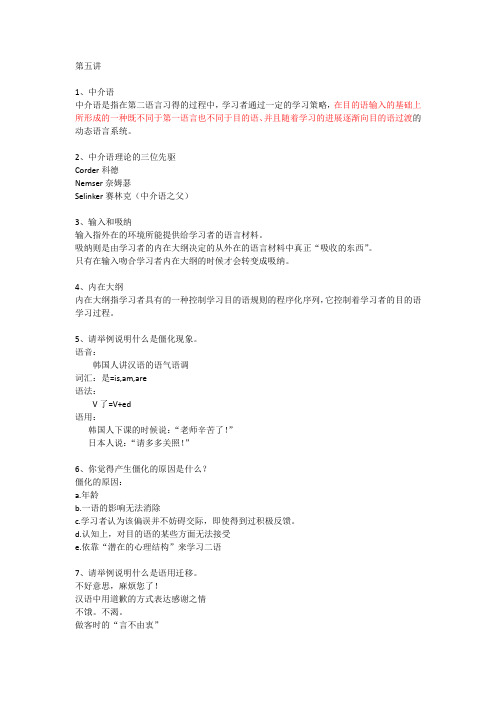
1.“了”的发展过程:习得汉语“了”经历了四个阶段
(1)准备阶段,未出现含有“了”的话语
(2)“了2”出现
(3)“了1”的出现并与相关结构“是……的”相混
(4)相关语法形式的相互冲突:“了”同“过”,“了1”同“了2”的冲突
2.主题突出的特征:主述题结构是汉语存在句的中介语的一个明显特征,且学生在学习的初级阶段就习得了汉语中最典型的主述题结构。
3.可能已经具备一些普遍的语言特征,这些特征可以在所有人类语言中找到,因此,许多语法属性可能是先天存在于人类的大脑中,无需学习。
3、第一语言语素习得研究有哪些成果?第二语言语素习得研究有哪些成果?
第一语言
Brown的纵向研究&Villiers等人的横向研究:
第二语言
Krashen(1982)
9个语素习得顺序:
语法:
V了=V+ed
语用:
韩国人下课的时候说:“老师辛苦了!”
日本人说:“请多多关照!”
6、你觉得产生僵化的原因是什么?
僵化的原因:
a.年龄
b.一语的影响无法消除
c.学习者认为该偏误并不妨碍交际,即使得到过积极反馈。
d.认知上,对目的语的某些方面无法接受
e.依靠“潜在的心理结构”来学习二语
7、请举例说明什么是语用迁移。
第五讲
1、中介语
中介语是指在第二语言习得的过程中,学习者通过一定的学习策略,在目的语输入的基础上所形成的一种既不同于第一语言也不同于目的语、并且随着学习的进展逐渐向目的语过渡的动态语言系统。
2、中介语理论的三位先驱
Corder科德
Nemser奈姆瑟
Selinker赛林克(中介语之父)
二语习得 中介语

小结
以上概念都是指称实际的混合语,是客观存在的 可观可感的语言。而中介语是一个学术概念,是 指二语习得者在没有完全通晓目的语的情况下受 母语影响而产生的一种虚拟语言系统。甚至每个 人的中介语都不一样,甚至同一个人在不同时期 的中介语都是有区别的。但一群人的中介语又有 一些相同的地方。所以说,中介语的提出目的、 存在方式和特点都是和以上众多混合语的概念完 全不同的,中介语与混合语最大的不同是中介语 是一种虚拟的语言过程,不是一种实际的语言。
四.重点讨论
(一) 中介语和皮钦语、混合语、克 里奥尔语、洋泾浜、中式英语的区别。
混合语:定义 皮钦语:起源 定义 克里奥尔语: 起源 定义
区别
洋泾浜是旧时汉语将pidgin译做洋径浜语,
专指在中国通商口岸出现的不纯粹英语。 后来随着学术的进步,洋泾浜被认为是中 国皮钦语,是皮钦语大家族在中国的分支。 皮钦语是泛指所有的尚未发展成为克里奥 尔语的混合语,洋泾浜是特指中国的皮钦 语,是皮钦语家族中的一员,与美拉尼西 亚皮钦语.英属所罗门群岛皮钦语、喀麦隆 皮钦语等并列。
形象类比
• 混合语 • 水果
野生水果 优质水果
皮钦语
克里奥尔语
美 拉 尼 西 亚 皮 钦 语
英 属 所 罗 门 群 岛 皮 钦
。 。 。 。 。 。 。 。
中介语 中 国 洋 泾 浜 中 式 英 语 网络娱乐用语 苹 果 梨 子
。 。 。 桔 。 子 。 。 。
糕点 橘 子 饼
过期变质 垃圾
(二)石化现象(僵化)/高原期的产生原因、 特征及影响、怎样克服?
C。.系统性(阶段性、规律性):
中介语的发展是分阶段的,如四阶段说, 随机错误阶段、突显阶段、系统形成阶段 和稳定阶段。而在每个阶段和从整个阶段 发展来看,中介语表现出一种较强的内部 一致性和系统性,甚至中介语中的偏误都 具有一种规律性特点。而石化现象也是也 是一种阶段性、规律性的体现。
二语习得中的中介语石化现象及对外语教学的启示

二语习得中的中介语石化现象及对外语教学的启示1 中介语石化现象中介语石化(Interlanguage Fossilization)是指学习者在学习外语过程中,把学习的外语进行思维处理,但最终产生的不是原汁原味的外语语言特点,而是保留其本身的母语语言结构的一种言语。
中介语石化也常常表现为学习者在说话时经常同时使用自己的母语特征、母语语音。
一般来说,当学习者来到一个外语环境,和一些母语者同时说话时,他们会憋住自己的母语,采取些许的外语发音,并取得一定程度的口头回复,但这些口头回复只是母语的表达方式,无法完全显示出外语的特点。
这就是中介语石化的现象。
2 对外语教学的启示中介语石化的出现,在外语教学实践中有很重要的指导作用。
首先,外语教师要尊重母语的影响,改变中介语石化现象最重要的方法就是帮助学习者发现他们自己的母语对学习外语的影响,并尽量避免这种影响。
学习者要清楚它们自己的母语结构特点,以及这些特点如何影响学习外语的过程,并加以利用,使自己掌握外语者的特点,不被自己的母语模式所约束。
其次,外语教学应考虑重视学习者的自身因素。
有些学习者学习外语时,会受到自身的特征影响,例如遗传背景、个性类型等在中介语石化的形成上起着至关重要的作用,而这些是学习者自身的因素,外语教师在教学时就要重视这些因素的影响。
最后,外语教师也要注意营造良好的学习氛围。
外语教学时,学习者学习外语的兴趣和动机是重要因素,在班级中发挥着举足轻重的作用,良好的激励机制能够让学习者有意识的让自己的外语进行改变,从而减少中介语石化的现象。
总之,中介语石化的现象对外语教学的启示要求教师要尊重母语的影响,有认识到学习者自身因素的影响,并积极营造良好的学习氛围,从而减少学习者中介语石化的现象,使学习者能够更好地掌握外语。
中介语在第二语言习得中的影响
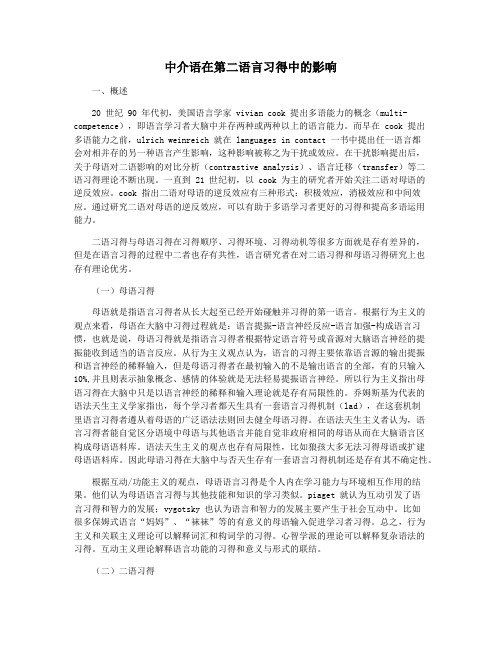
中介语在第二语言习得中的影响一、概述20 世纪 90 年代初,美国语言学家 vivian cook 提出多语能力的概念(multi-competence),即语言学习者大脑中并存两种或两种以上的语言能力。
而早在 cook 提出多语能力之前,ulrich weinreich 就在 languages in contact 一书中提出任一语言都会对相并存的另一种语言产生影响,这种影响被称之为干扰或效应。
在干扰影响提出后,关于母语对二语影响的对比分析(contrastive analysis)、语言迁移(transfer)等二语习得理论不断出现。
一直到 21 世纪初,以 cook 为主的研究者开始关注二语对母语的逆反效应。
cook 指出二语对母语的逆反效应有三种形式:积极效应,消极效应和中间效应。
通过研究二语对母语的逆反效应,可以有助于多语学习者更好的习得和提高多语运用能力。
二语习得与母语习得在习得顺序、习得环境、习得动机等很多方面就是存有差异的,但是在语言习得的过程中二者也存有共性,语言研究者在对二语习得和母语习得研究上也存有理论优劣。
(一)母语习得母语就是指语言习得者从长大起至已经开始碰触并习得的第一语言。
根据行为主义的观点来看,母语在大脑中习得过程就是:语言提振-语言神经反应-语言加强-构成语言习惯,也就是说,母语习得就是指语言习得者根据特定语言符号或音源对大脑语言神经的提振能收到适当的语言反应。
从行为主义观点认为,语言的习得主要依靠语言源的输出提振和语言神经的稀释输入,但是母语习得者在最初输入的不是输出语言的全部,有的只输入10%,并且则表示抽象概念、感情的体验就是无法轻易提振语言神经。
所以行为主义指出母语习得在大脑中只是以语言神经的稀释和输入理论就是存有局限性的。
乔姆斯基为代表的语法天生主义学家指出,每个学习者都天生具有一套语言习得机制(lad),在这套机制里语言习得者遵从着母语的广泛语法法则回去健全母语习得。
二语习得中介语石化现象及其教学启示
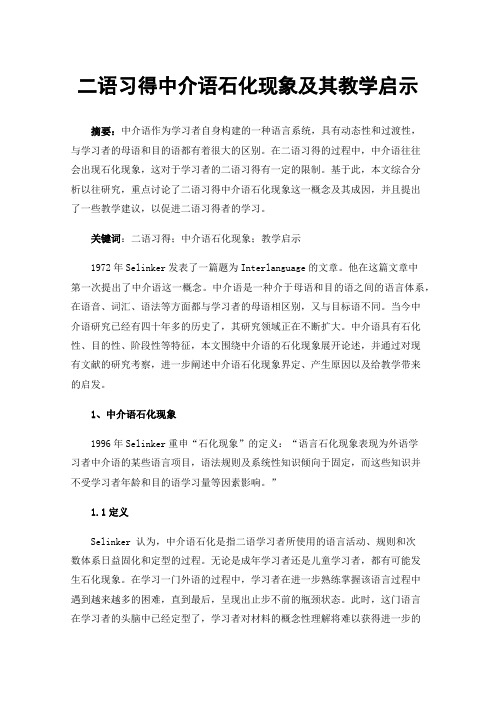
二语习得中介语石化现象及其教学启示摘要:中介语作为学习者自身构建的一种语言系统,具有动态性和过渡性,与学习者的母语和目的语都有着很大的区别。
在二语习得的过程中,中介语往往会出现石化现象,这对于学习者的二语习得有一定的限制。
基于此,本文综合分析以往研究,重点讨论了二语习得中介语石化现象这一概念及其成因,并且提出了一些教学建议,以促进二语习得者的学习。
关键词:二语习得;中介语石化现象;教学启示1972年Selinker发表了一篇题为Interlanguage的文章。
他在这篇文章中第一次提出了中介语这一概念。
中介语是一种介于母语和目的语之间的语言体系,在语音、词汇、语法等方面都与学习者的母语相区别,又与目标语不同。
当今中介语研究已经有四十年多的历史了,其研究领域正在不断扩大。
中介语具有石化性、目的性、阶段性等特征,本文围绕中介语的石化现象展开论述,并通过对现有文献的研究考察,进一步阐述中介语石化现象界定、产生原因以及给教学带来的启发。
1、中介语石化现象1996年Selinker重申“石化现象”的定义:“语言石化现象表现为外语学习者中介语的某些语言项目,语法规则及系统性知识倾向于固定,而这些知识并不受学习者年龄和目的语学习量等因素影响。
”1.1定义Selinker 认为,中介语石化是指二语学习者所使用的语言活动、规则和次数体系日益固化和定型的过程。
无论是成年学习者还是儿童学习者,都有可能发生石化现象。
在学习一门外语的过程中,学习者在进一步熟练掌握该语言过程中遇到越来越多的困难,直到最后,呈现出止步不前的瓶颈状态。
此时,这门语言在学习者的头脑中已经定型了,学习者对材料的概念性理解将难以获得进一步的提高,石化是语言学习中的一种不可逆转的停滞现象。
中介语的石化表现在语音、词汇、句法等多个语言层面,如我们在学习英语过程中常见的“中国式英语”现象,初学者可能会根据汉语思维说出“I very thank you”这种既不像汉语也不像英语的语言。
第二语言习得的中介语理论述评
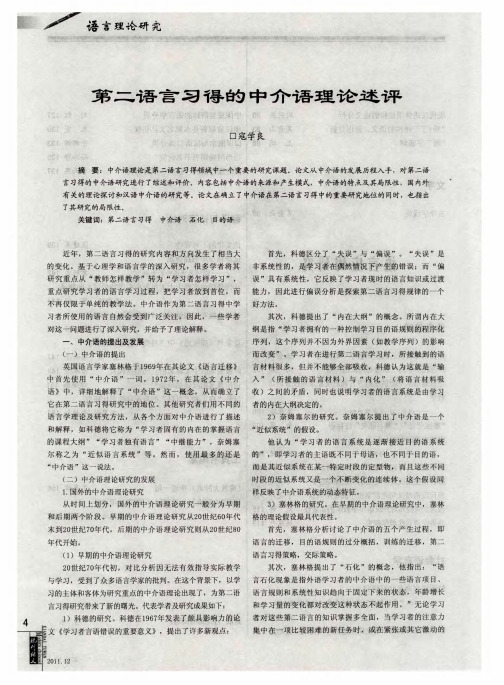
情况 下,类似错 误总会重 复出现 ,甚 至在极度放松 的情况
下 或 很短 时 间不 说 目的语 的情 况 下 也会 出现 。
李大忠在 实际教学 中积 累 了大量 的留学生偏误实例并
写 成 《 “ ” 字 兼 语 句 偏 误 分 析 》 一 文 。此 文 对 留 学 生 产 使
2 )舒 曼 的研 究 。舒 曼 提 出 了 “ 化适 应模 式 ” ,从 社 性也不是很 强 。经过 多年 的努力 ,储诚 志、陈小荷等人建 文
会 环境 因素和学 习者个 人 因素 的视 角对第 二语言 习得 的动 立的 “ 汉语 中介语语料库 ”于 1 9 年 1 月1 日通过专家鉴 95 1 5 力机 制及 学习者语言 的中介语现象 作 出了独 到 的解释 ,为 定。该系统不仅是对外汉语教学研究、中介语研究和汉语研
1 )埃利 斯 的研 究 。首先 ,埃利 斯和 道 朗提 出了中介 计和偏误 的收集结合起 来,把定性研 究建立在定量分析 的
留 语的 “ 可变能力模 式 ”,从社 会语 言学的角度来解 释学 习 基 础 上 完 成 了 《 学 生 的 代 词 偏 误 与 代 词 在 篇 章 中 的 使用
者的语 言变异 。应 该说 ,这个 模式是在 最初的 中介 语理论 原 则 》一 文 。
二 、 中介 语 的概 念及 特 点 所谓 “ 介 语 ” ,就 是介 于 学生本 族 语和 目的语之 中
般认为 ,18 年鲁健骥发表 的 《 94 中介语理论与外国人
学 习汉语的语音偏误分析》一 文是我国中介语理论研究的开 间 的独 立的语言系 统,它是第 二语 言学 习者创造 的语言系 端 。我 国的中介语理论是在研 究国外 中介语理论和研究方法 统。科德称 它为具有独特 风格 的 “ 异方言 ”或 “ 言学 特 语 的基础上发展起来 的。代表学者及研究成果如下:
第二语言习得中介语的研究

•刘范刘雨林刘洪利曹丽华本章结构中介语理论产生的历史背景早期的中介语研究三个关于中介语的基本假设早期的中介语理论研究王建勤对基本内容的概括与早期研究的关系后续关于中介语的研究汉语学习者中介语研究中介语语用研究主要内容中介语产生的历史背景早期的中介语研究早期中介语的基本假设及后续研究中介语语用研究•中介语理论产生的历史背景早期中介语理论提出与发展的必然性20世纪50年代——行为主义心理学与结构主义语言学兴盛,语言教学和研究上对比分析一统天下60年代后期,人们发现对比分析作为一种理论方法无论在理论还是实践上都面临严重挑战【试图用简单的语言学方法来解决复杂的心理学问题】1967年,Corder发表《学习者偏误的意义》与Selinker于1972年发表的《中介语》被视为二语习得研究领域的开端、学科建立的标志——P17】,将研究对象转到学习者身上偏误分析不顾及学习者正确的方面——仅仅用观察到得偏误去推测学习者的整个语言系统难免以偏概全。
Selinker(1972), Corder(1967,1971)以及Nemser(1971)几乎在同一时间提出了大致相同的理论。
这三人的理论主张构成了早期中介语理论。
.①行为主义心理学——美国现代心理学的主要流派之一,也是对西方心理学影响最大的流派之一。
旧行为主义代表——华生(创始人);新行为主义代表——斯金纳。
•核心观点——除极少数的简单反射外,一切复杂行为都取决于环境影响,而这种影响是通过条件反射实现的。
——华生。
(经典条件作用、操作性条件作用)②结构主义语言学——以20世纪费尔迪南-德-索绪尔的语言学理论为代表以及受这种理论影响而进行的语言理论研究。
1916年,索绪尔的《普通语言学教程》出版,标志着结构主义语言学的诞生。
•核心观点——语言是一个完整的符号系统,具有分层次的形式结构;在描写语言结构的各个层次时,特别注重分析各种对立成分。
•什么是早期中介语理论?由Selinker(1972),Corder(1967,1971)和Nemser(1971)的理论主张构成。
二语习得中介语总结

第三节中介语一、中介语研究概说(一)什么是中介语中介语理论是在认知心理学理论基础上发展起来的。
美国学者L•Selinker于1969年最早提出这一概念,并于1972年在其题为《Interlanguage》的论文中首次使用"Interlanguage"(中介语)这一术语。
中介语是在第二语言习得中产生的,是介于母语和目的语之间的过渡性语言,随着学习者语言知识和交际能力的不断提高,其中介语体系会日趋丰富完善,并逐渐向目的语靠近。
因此从学习过程来说,它同学习活动是密切相关的。
随着学习者水平的提高,低层次的中介语将不断消失,而高层次的中介语将会出现。
它是一动态变化的过程,汉姆莱(Hammerly)曾用图形象地表示出了中介语与目的语之间的关系(1975)如下图所示:从上图可以看出中介语不是两种语言的直接混合,实质上它是不同心理过程与母语和目的语相互作用的结果,是多种因素的"混合"。
Ellis(1994)认为中介语的形成是-个重新创造的过程。
中介语作为一种独立的语言系统有其自身的语言规则(阴影不重合部分),同时它还具有与母语和目的语相似的规则(阴影重合部分)。
学习者的第二语言学习是从零点开始不断向目的话靠近的渐变过程。
它随着第二语言新知识的增加而不断变化。
W•Nemser(l971)把此系统称之为"渐近系统"(approximative systems)。
他认为学习者的这一系统是从零知识(zero knowledge)沿着一连续体(continuum)逐渐接近本族语使用者的语言能力(native speaker competence)。
他认为,"大部分第二语言学习者都处于这一连续体的某一位置,因此中介语不应被看作是静态的、固定不变的,它是处在不断修正,不断向目的语规则接近的过程中的。
"(二)中介语的形成模式及特点1.中介语的产生及形成模式中介语是在第二语言学习过程中的一定阶段才产生的。
四种二语习得理论
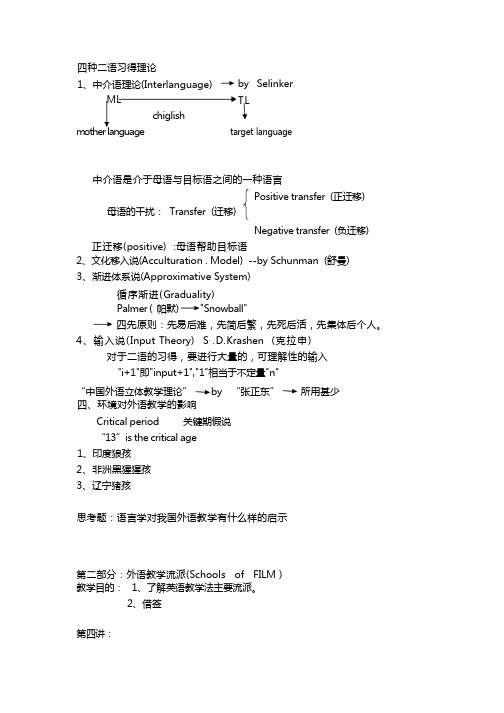
第四讲:四种二语习得理论1、中介语理论(Interlanguage)MLchiglishm other language中介语是介于母语与目标语之间的一种语言Positive transfer (正迁移)母语的干扰: Transfer (迁移)Negative transfer (负迁移)正迁移(positive) :母语帮助目标语2、文化移入说(Acculturation . Model) --by Schunman (舒曼)3、渐进体系说(Approximative System)循序渐进(Graduality)Palmer ( 帕默) "Snowball"四先原则:先易后难,先简后繁,先死后活,先集体后个人。
4、输入说(Input Theory) S .D.Krashen (克拉申)对于二语的习得,要进行大量的,可理解性的输入"i+1"即"input+1","1"相当于不定量"n"“中国外语立体教学理论”by “张正东” 所用甚少 四、环境对外语教学的影响Critical period 关键期假说“13”is the critical age1、印度狼孩2、非洲黑猩猩孩3、辽宁猪孩思考题:语言学对我国外语教学有什么样的启示第二部分:外语教学流派(Schools of FILM )教学目的: 1、了解英语教学法主要流派。
2、借签by Selinker TL target language一、 FLIM: Foreign Language Teaching Methods(一) .GTM (语法翻译法) ----Grammar Translation Methods始于 18 世纪末 19 世纪中,源于欧洲 (西欧), (18 世纪前的拉丁语)中国从 1872 年开始,同文馆标志着中国班级教学的开始。
浅析二语习得过程中的中介语现象

第二语言习得 的研究是从 2 0世纪后半叶开始的。当时,地 语 是一种值得 独立研 究的语言形式 ,再这样认为就不合逻辑 “ 球 村” 世界网”的观念使人们认识到学习第二语言的重要性。 就 好像相对于标准语,把方言说成错误 ,或者把儿童语说成是 、“ 语 言教学逐渐成了一门新兴 的学 科,许 多关于语 言学 和教育学 成 人语的异种一样 ,中介语理 论考虑了语言学 习和语言教学 的 的发现 引起人们的注意,在这种情 形下产生的第二语 言习得理 多 种变 因,以语 言习得为研 究 中心 ,把语言对 比分析、 比较 文
感 过滤假设 ( e A fcie FR r Hy oh s )在 “ Th fet ie p t ei v s 第二语 种严 重的错误 ,要认识到它是一个发展 过程 中的错 误,要利用
言 习 得 ” 理 论 中是 有 代 表 性 的 。 在 他 之 前 的 No m C o k 中介 语在学 习过程 中的作用 ,尤 其他在 交 际方面所 起 的作用, a h ms y
论 研 究 ,顺 应 了 当时 的历 史潮 流 。
化研 究和语言习得 有机结合 起来,试图建立一种语言学习者 的
何谓 “ 第二语言”呢?根据掌握语言 的顺序, 母语 是第一语 动态语 言系统 ,这对 发展 语言学习及语言教学理论有极其重要 言,第二语言指的是任何一门在母语之后学的语言,所以也可以 的意 义 。 指 第三 或第四语 言的学习。从 2 0世纪 5 0年代开始,第二语言
二语习得中的中介语

误和局部错误。整体错误会影响句子的意义从而导 致交流障碍,局部错误只会影响到局部句子成分的 意义不会对交流产生影响。对待这两种错误要根据 不同场合区别对待。 其次,教师在纠正错误过程中应考虑到学习者 的性格特点。 作为个体学习者, 每个人都有自己独特 的性格特点, 存在个体差异。 教师应当充分了解学习 者的个性, 根据不同的性格进行纠错。 最后,教师可根据学习者所处的环境对学生学 习和使用英语中的各种变异加以观察和分析,引导 其学习。作为教师应根据不同的场合对学生做不同 的要求,特别要为学生创造学习和使用英语的各种 环境。使学生在课堂上学得的规则有机会在真实或 接近真实实践的环境中逐步脱离母语的干扰而被真 正习得。 五、 中介语对外语教学的意义 */ 帮助英语教师检测教学效果和识别学生的 不足, 使教学更具有针对性, 提高教学效果。 +/ 使教师更加深入观察和理解二语习得中出 现的问题, 分析二语习得过程中出现的错误。 对学习者的 ,/ 教师对学习者进行长期的观察, 进步做出全面客观的评价。 对中介语的研究尽管争议纷纭,但它对第二语 言的习得有着不可忽略的作用,因此应结合教学实 践加强对这一问题的研究,总结规律从而切实推动 外语教学的发展。 参考文献: */ 0$1 23345 &6) 7891: $; 7)<$(1 !"(=9"=) ><? @945484$( A B C 上海外语教育出版社, +DD+/ 0$("31 E"’16"9=6 >( F(8’$19<84$( 8$ 7$<4? $34(=94584<5 A B C 外语教学与研究出版社 , +DDD ,/ G4"() !"’5)( H I’))J"( K B4<6")3 L/ !$(= >( F(8’$19<84$( 8$ 7)<$(1 !"(=9"=) ><@945484$( 0)? 5)"’<6 A B C 外语教学与研究出版社 , +DDD 心理语言学 A B C 上海: 上海外语教 -/ 桂诗春, 育出版社, *MN. (作者单位: 抚顺职业技术学院) (责任编辑: 温去非)
浅谈二语习得过程中中介语的僵化现象

浅谈二语习得过程中中介语的僵化现象1引言中介语(inter-language)是由Selinger于1969年首次提出,并于1972年在其题为《inter-language》的论文中首次使用。
它是指外语学习过程中学习者使用的介于母语(native language)与目标语(targetlanguage)之间的一种语言体系。
Selinger 对中介语的定义含有两层意思:“一是指二语学习者在学习过程中的某一特定阶段认知目标语的方式和结果的特征系统;二是指所有学习者在二语习得的整个过程中,二语能力发生和发展的特征性系统” (戴炜栋、蔡龙权,2001)。
前者是指某一学习个体的、某一特定的、具体的中介语语言(an inter-language),后者是指所有二语习得者所表现出来的一种普遍的,抽象的中介语语言体系(the inter-language continuum),也称“中介语连续体”。
中介语既不同于学习者的母语,又区别于学习者的目标语。
二语习得者都是从母语出发,经过中介语,达到目标语。
中介语是母语和目标语之间的一座桥梁,是二语习得中认知过程的必经之路。
中介语是一种既独立于母语和目标语之外,同时与两者有着密切相关性的语言体系。
中国学生在学习英语的过程当中,因为受到母语的干扰和影响,存在着很多与中介语相关的问题,以及中介语的僵化现象,而民族预科学生同样不能例外。
少数民族预科教育是我国高等教育的重要组成部分,其主要任务是帮助少数民族学生未进入大学而补习基础知识或提高语言能力。
预科教育起着承上启下,继往开来的衔接作用。
本文拟通过中介语的相关理论,结合实证调查,分析民族预科学生在英语学习过程中的困难,为更好的进行预科英语教学提供一点参考。
2中介语的特性语言学习是一种认知行为,应当遵循人类共同的认知规律。
按照认知心理学的观点,人的知识有两大类,一类是陈述性知识,一类是程序性知识(转引自周红云,2003)。
Anderson(1980:223-256)认为陈述性知识获得的关键是记忆,而程序性知识的获得要复杂的多,它需要三个阶段:①陈述性阶段,②联结阶段,③自动化阶段。
二语习得中介语 ppt课件

二语习得中介语
14
Variability in interlanguage
Non-systematic variability
Systematic variability
Perfornmance variability
Free variability
Individual variability
Contextual variability
二语习得中介语
22
In1980s: introduction and evaluation, Hu zhuanglin(1984), Gui shichun(1985)
In1990s: overall introduction and study based on the current teaching situation in China, Yan lianrui(1996), Dai manchun (1998)
(2) Systematic: interlanguage is governed by rules which constitute the learner’s internal grammar systematically.
二语习得中介语
11
(3) Dynamic
A
B
Mother tongue
二语习得中介语
4
(2) In 1980s Corder (1981): Error Analysis and nterlanguage Ioup and Weinberge (1987): Interlanguage Phonology Tarone (1988): Variation in Interlanguage
《二语习得中介语》课件

研究多语种中介语,有利于深入探讨不同语言之间的差异及其相互影响。
2
挖掘语言中的规律和内在联系
多语种中介语研究在探索语言习得规律和语言内部联系方面具有独特的价值和意 义。
3
促进语言教育和教学的发展
多语种中介语研究可以帮助我们更好地设计教材,促进语言教育和教学的发展。
中介语与跨文化沟通的关系
促进文化交流
双语中介语(L1 -L2 /L2 L1)
双语中介语指的是两种语言 互相影响的情况,语言语调、 语法等方面均受到影响。
中介语对教育和教学的启示
1
鼓励多语种学习
中介语研究表明:掌握多语种有利于认知、思维和跨文化交际等方面的发展。
2
引导合理中介语使用
教师应正确引导学生使用中介语,并充分利用其促进二语习得的作用。
中介语对语言政策和双语教育政策制定和实施提供了依据, 促进了双语教育事业的发展。
引导口语政策制定
中介语现象的特点,可以为口语政策制定提供参考, 引导政策实现最佳效果。
中介语研究的未来发展方向
多学科交叉
中介语研究需要多种学科交 叉,往往涉及到语言学、认 知心理学、教育学、语料库 语言学等。
3
注重学习策略
中介语的出现意味着学生开始形成自己的语言意识,有助于教师引导学生更好的 运用学习策略。
中介语在语言测试中的应用
考查经验和语言能力
适当引入中介语因素,有利于考查学生实际的语言 运用能力,反映出其语言习得水平。
测试各种语言技能
在听、说、读、写多种类型的题目中,适当引入或 调整中介语的使用,可全面检测学生的各类语言技 能。
3
变异性模型
受到习得者个体差异、语言环境差异和语言结构差异等多种因素的影响。
浅议第二语言习得理论中的中介语
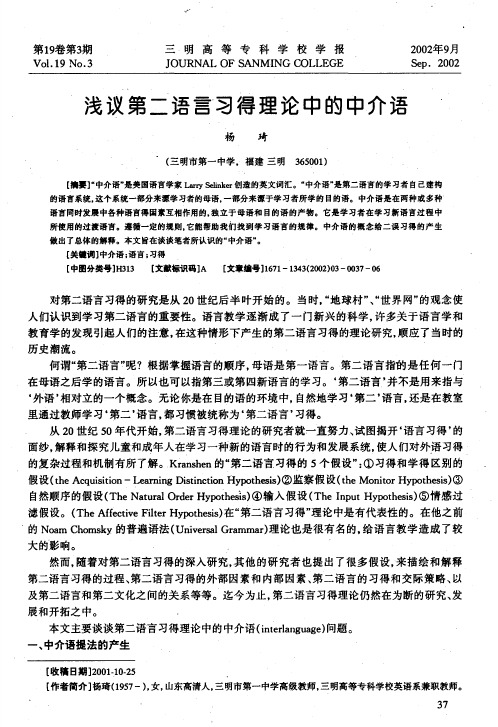
logical distance) 的 提法。 但是, Shuman 忽视了一些因素的可变性, 学习 者并不绝对屈从于社
会环境, 他们完全可以构建自己学习的社会环境。③第二语言的学习者用于和本族语的人交
际的 不同的社会身份, 提供了 说和学第二语言的不同的机会。Peirce 认为学习者的身份是多
重性的, 冲突的。只有当学习者能够在一定的范围内找到倾听者, 他们才有可能使自己的学习 获得成功。
二、 中介语的特征
( 一) 社会特征
中介语的社会性表现在: ①学习者在不同的语境使用不同语体。Elaine Tarone 提出语体 持续统一体(stylistic continuum) 的观点。在持续体的一端是谨慎语体(careful style) , 学习者 有意识地对使用的语体作出选择, 以求正确。在持续统一体的另一端是流行语体 (vernacular style) , 学习者自由随意地选择各种语体。②社会因素决定学习者所使用的输入来构建自己的 中介语。 J ohn Shuman 提出的文化移入模式(acculturation model) 可以说明这具问题。Shuman 认为学习过程最重要的是社会因素和个人因素, 学习者无法进行文化移入的主要原因是社会 距离(social distance) 。同时他看到社会距离的提法不够完善, 就又增加了心理距离(psycho-
然而随着对第二语言习得的深入研究其他的研究者也提出了很多假设来描绘和解释第二语言习得的过程第二语言习得的外部因素和内部因素第二语言的习得和交际策略以及第二语言和第二文化之间的关系等等
第19卷第3期
Vol . 19 No . 3
三 明 高 等 专 科 学 校 学 报
J OU RNAL OF SAW IN G COLLEGE
- 1、下载文档前请自行甄别文档内容的完整性,平台不提供额外的编辑、内容补充、找答案等附加服务。
- 2、"仅部分预览"的文档,不可在线预览部分如存在完整性等问题,可反馈申请退款(可完整预览的文档不适用该条件!)。
- 3、如文档侵犯您的权益,请联系客服反馈,我们会尽快为您处理(人工客服工作时间:9:00-18:30)。
Interlanguage Variability
Variability in interlanguage
Non-systematic va源自iabilitySystematic variability
Perfornmance variability
Free variability
Individual variability
fossilization
types
Individual fossilization and group fossilization
Permanent fossilization and temporary fossilization
Five Processes leading to fossilization
interlanguage Stage 0 Stage 1 Stage 2 Stage 3 ……
(4) Independent
Native language Target language
interlanguage
(Hammerly, 1975)
(5) Variable: differences in context (linguistic context, psychological context and microsocial context) result in different patterns of language.
(2) In 1980s Corder (1981): Error Analysis and Interlanguage Ioup and Weinberge (1987): Interlanguage Phonology Tarone (1988): Variation in Interlanguage
References
[1] Ellis, R. 1997. Second Language Acquisition. Oxford: Oxford University Press. [2] Gass, S. and Selinker, L. 2008. Second Language Acquisition. New York: Routledge. [3] Larsen-Freeman, D. and Long. H.M. 1991. An Introduction to Second Language Acquisition Research. London: Longman Group Limited. [4] Saville-Troike, M. 2005. Introducing Second Language Acquisition. Cambridge: Cambridge University Press. [5] Selinker, L. 1972. Interlanguage. International Review of Applied Linguistics, 10,209-231.
(1) Scholars who conduct research on Chinese as a foreign language Lu jijian (1984): The Interlanguage Theory and Chinese Pronunciation Error Analysis of Foreign Learners Lv bisong (1993): meaning and strategies Wang jianqin (1994): foreign research on interlanguage
(1) Language transfer (2) Transfer of training (3) Strategies of second language learning (4) Strategies of second language communication (5) Overgeneralization (Selinker, 1972)
(2) Scholars who conduct research on English as a foreign language in China In1980s: introduction and evaluation, Hu zhuanglin(1984), Gui shichun(1985) In1990s: overall introduction and study based on the current teaching situation in China, Yan lianrui(1996), Dai manchun (1998)
Interlanguage
Contents
• • • • • • I. Definition II. Related Research III. Characteristics of Interlanguage IV. Methods of studying Interlanguage V. Conclusion VI. References
V. Conclusion
Interlanguage theory has been raised for over twenty years, but its domestic research is still in low progress and there is no systematic research results. Compared with the abroad, domestic research field is quite narrow. Therefore, interlanguage research should be strengthened to guide our foreign language teaching.
(3) In 1990s Selinker (1992): Rediscovering Interlanguage Gabriel Kasper (1993): Interlanguage Pragmatics Yip (1995): Interlanguage and Learnability, Chinese-English Interlanguage
(4) In recent years Grady (2003): general nativism(先天论) Pienemann ( 2003): the multidimensional model (多元发展模式), processibility theory(可加工行理论)
2. Research in China
(2) Systematic: interlanguage is governed by rules which constitute the learner’s internal grammar systematically.
(3) Dynamic
A
Mother tongue
B
Target language
Contextual variability
(Based on Ellis, 1985)
Situational context
Linguistic context
(6) Fossilized
Fossilization is a term researchers in SLA use to refer to a stage of second language development when it stops.
III. Characteristics of interlanguage
(1) Permeable (2) Systematic (3) Dynamic (4) Independent (5) Variable (6) Fossilized
(1) Permeable: any rule in interlanguage system changes as the learning process progresses.
[6] 林立. 2007. 第二语言习得:理论与实践 [M]. 北京:高等教育出版社. [7] 刘颂浩. 2007. 第二语言习得导论-对外汉 语教学视角[M]. 北京:世界图书出版公司. [8] 杨连瑞等著. 2007. 二语习得与中国外语教学 [M]. 上海:上海外语教育出版社. [9] 杨连瑞. 2010. 二语习得多学科研究[M]. 青岛: 中国海洋大学出版社.
I. Definition
Interlanguage refers to the separateness of a second language learner system, a system that has a structurally intermediate status between native and target language. (Selinker,1972)
IV. Methods for studying interlanguage
• • • • (1) Observation (2) Experiment (3) Comparison (4) Analysis
Problems Existing in Research Method
Lightbown(1984): (1) Less related materials (2) Single situation, single method (3) Improper way of collecting data Wan jianqin(2000): (4) Less quantitative study (5) Lack of clear theoretical framework
II. Related Research
1. Foreign Research (1) In 1970s
